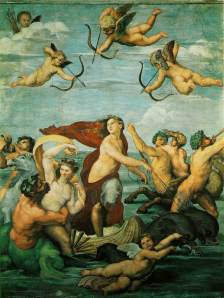The visual art piece I chose is from the Italian Renaissance period. The above painting is by Raphael and is titled The Triumph of Galatea. (Below you will find a short video summarizing the painting.) This fresco masterpiece was completed in 1513 and was inspired by the following poetic excerpt, as well as Greek mythology.
Two shapely dolphins pull a chariot: on it sits
Galatea and wields the reins; as they swim, they
breath in unison; a more wanton flock circles
around them: one spews forth salt waves, others
swim in circles, one seems to cavort and play for
love; with her faithful sisters, the fair nymph
charmingly laughs at such a crude singer.
Angelo Poliziano, Stanze per la giostra, 1:118, 1475, translated by David Quint (Source 1)
Galatea was painted in the villa Farnesina for one of the richest men in Italy during this time, Agostino Chigi. (Source 3)
In the painting, sea-nymph Galatea is surrounded by sea creatures whose forms are inspired by Michelangelo. The bright colors and decoration are supposed to be inspired by ancient Roman painting. Italian writer said that Raphael did not mean for Galatea to resemble any one person, but rather to represent ideal beauty. That being said, it appears that Raphael abandoned the old portrayal of nature and instead used an imagined type of regularly beauty demonstrating that the normal human body is beautiful!
Watch the short video describing the painting here:
https://www.youtube.com/watch?v=QEA30X4ysvg#t=111
Humanism:
For those who are unaware, humanism is a system of thought attaching prime importance to humans rather than that of divine or supernatural matters. During the Renaissance, humanism was a cultural movement that turned away from medieval academicism and revived interest in Greek and Roman thought. This painting by Raphael is a great example of how humanism was portrayed in the arts during this time frame.
When I look at this piece of work, the first thing I notice is the use of bright colors. As stated before, the colors were inspired by ancient Roman painting. Raphael uses his humanistic values to tie this work to the interest in Greek and Roman thought. The next thing I notice are the bodies; they are done in great detail! One can see the outline of each muscle, the roll of a stomach, the chubbiness of the angels’ legs. Even the sea creatures, horses, and dolphins are painted in a way that they are realistic looking based on the muscle groups displayed alone. This way of painting depicts the realness of each and every being in the work. Lastly, the piece is very nicely balanced. Notice how Galatea is being pulled to the right; however, her hair and cloak is being blown to the left. Not only that, but she is surrounded by three groups of three. Three angles are directly above her, three sea creatures are to her left, and three sea creatures are to her right. Every figure corresponds with another figure and for every movement, there is a counter movement. Raphael managed to perfectly capture the moment of Galatea hearing Polyphemus’s song.
During my research, one interesting thing I learned is that an object’s placement in a picture depended upon the relative proportion of spirit and matter it contained. For example, the less spirit and the more matter and object contained, the lower down it would appear in the painting. (Source 2)
In this piece, Raphael accomplished the composition of freely moving figures, something every artist struggles with. I personally think this painting is a great work of art and was crafted with astounding merit.
Works Cited:
- http://smarthistory.khanacademy.org/galatea.html
- Lexis Art Lover. “Chain of Being.” : Chain of Being. Blogspot, 23 Apr. 2007. Web. 25 Sept. 2014. <http://renaissanceandart.blogspot.com/2007/04/chain-of-being_23.html>.
- Gombrich, E. H. “Raphael: The Nymph Galatea.” The Story of Art. The Artchive, n.d. Web. 25 Sept. 2014. <http://www.artchive.com/artchive/R/raphael/galatea.jpg.html>.
